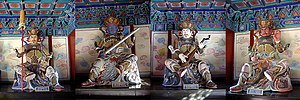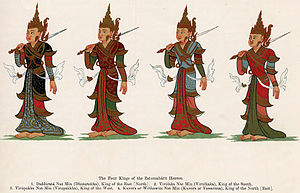Four great kings

Four great kings (Skt. Caturmahārāja; T. rgyal po chen po bzhi) are four devas of the sensuous realm (kamadhatu) that reside with their retinues in the "realm of the four great kings" (cāturmahārājakāyika), which is the lowest of the six deva realms of the kāmadhātu.[1]
The four great kings (mahārāja), along with their retinues, reside upon the fourth terrace of Mount Meru.[2] The lesser devas, who are their subjects, reside mainly on the lower terraces.
The four great kings are also referred to as the "guardians of the world" (lokapala) They are said to "serve as protectors of the dharma and of sentient beings who are devoted to the dharma".[1] Each great king (mahārāja) watches over one cardinal direction of the world.
The four great kings (mahārāja) are:
- Dhritarashtra ("one whose realm is stable") in the east
- Virudhaka ("sprouting forth") in the south
- Virupaksha ("dreadful eye") in the west
- Vaishravana, 'Son of He who has Heard Many Things' in the north
Myriad Worlds states:
- The Four Groups of the Great Kings constitutes the first [i.e., the lowest] of the six classes of gods of the kāmadhātu. The gods of this class reside mainly on the terraces of Mount Meru. The Vessel-Bearers live on the first terrace; Garland-Bearers, on the second; and Inebriates, on the third. Their kings, the four great kings, reside in the four directions of the fourth terrace. The gods in the kings' entourage generally reside [in the same place as the kings], but may also dwell in various other places, wherever suitable, be it in space or on one of the seven mountain ranges, such as Yoke.
- In brief, the beings [commonly associated] with environments from the hell-realm to this level of heaven may dwell in various other unspecified secondary abodes. Even the mountains, cliffs, trees, temples, and homes of this human realm, wherever suitable, may serve as the habitat or environment for any of these forms of life.[3]
Ornament of Abhidharma states:
- For the gods of Cāturmahārājika... fifty human years is calculated as one day and night. The measure of their lifespan is five hundred years, where thirty such days make one month and twelve such months make one year...[4]
Etymology
The Sanskrit term Caturmahārāja consists of three words:
- catur means "four"
- mahā means "great"
- rāja means "king"
Hence, "four great kings."
Title variants
The four kings are also referred to as:
- Caturmahārājikādeva, literally "four great deva kings." Sometimes translated as "four great heavenly kings."
In Chinese mythology, they are known collectively as:
- "Fēng Tiáo Yǔ Shùn" (simplified Chinese: 风调雨顺; traditional Chinese: 風調雨順; literally: "Good climate") or
- "Sì Dà Tiānwáng" (Chinese: 四大天王; literally: "Four Great Heavenly Kings").
In English, they are also referred to as the:
Notes
- ↑ 1.0 1.1 Buswell & Lopez 2014, s.v. Caturmahārāja.
- ↑ Mipham Rinpoche 2000, s.v. line 8.27.
- ↑ Jamgön Kongtrul 2003, p. 116.
- ↑ Chim Jampaiyang 2019, s.v. Chapter 17.
- ↑
 rgyal po chen po bzhi, Christian-Steinert Dictionary
rgyal po chen po bzhi, Christian-Steinert Dictionary
- ↑
 rnam thos sras, Christian-Steinert Dictionary
rnam thos sras, Christian-Steinert Dictionary
Sources
 Buswell, Robert E.; Lopez, Donald S. (2014), The Princeton Dictionary of Buddhism, Princeton University
Buswell, Robert E.; Lopez, Donald S. (2014), The Princeton Dictionary of Buddhism, Princeton University Chim Jampaiyang (2019), Jinpa, Thupten, ed., Ornament of Abhidharma: A Commentary on Vasubandhu's Abhidharmakosa, translated by Coghlan, Ian James (Apple Books ed.), Library of Tibetan Classics
Chim Jampaiyang (2019), Jinpa, Thupten, ed., Ornament of Abhidharma: A Commentary on Vasubandhu's Abhidharmakosa, translated by Coghlan, Ian James (Apple Books ed.), Library of Tibetan Classics Jamgön Kongtrul (2003), Myriad Worlds, The Treasury of Knowledge, Book One, Snow Lion
Jamgön Kongtrul (2003), Myriad Worlds, The Treasury of Knowledge, Book One, Snow Lion Mipham Rinpoche (2000), Gateway to Knowledge, vol. II, translated by Kunsang, Erik Pema, Rangjung Yeshe Publications
Mipham Rinpoche (2000), Gateway to Knowledge, vol. II, translated by Kunsang, Erik Pema, Rangjung Yeshe Publications
Further reading
 Four Heavenly Kings, Wikipedia
Four Heavenly Kings, Wikipedia Four Great Kings, Rigpa Shedra Wiki
Four Great Kings, Rigpa Shedra Wiki rgyal po chen po bzhi, Christian-Steinert Dictionary
rgyal po chen po bzhi, Christian-Steinert Dictionary Buddhist Protector: Four Guardian Kings Main Page, Himalayan Art Resources
Buddhist Protector: Four Guardian Kings Main Page, Himalayan Art Resources
